MGT604 - Globalization's Impact on Cross-Cultural Communication
VerifiedAdded on 2023/05/29
|7
|1722
|298
Annotated Bibliography
AI Summary
This annotated bibliography examines the impact of globalization on cross-cultural communication within the supermarket industry. It includes five summaries of research-based academic journal articles, each providing a description of the article's content, relevance to the research question, nature of the research (sample, methods, and analysis), and key findings and implications for managers. The articles explore various aspects of cross-cultural communication, including barriers in the workplace, the influence of cultural values, the role of self-concept, challenges faced by managers in intercultural settings, and the benefits and challenges of intercultural communication in global businesses. Each summary also includes a critique, reflection, and evaluation of the source's scope, limitations, and strengths, highlighting its usefulness for further research and its contribution to understanding the complexities of cross-cultural communication in a globalized work environment. The student submission is available on Desklib, a platform which provides all the necessary AI based study tools for students.
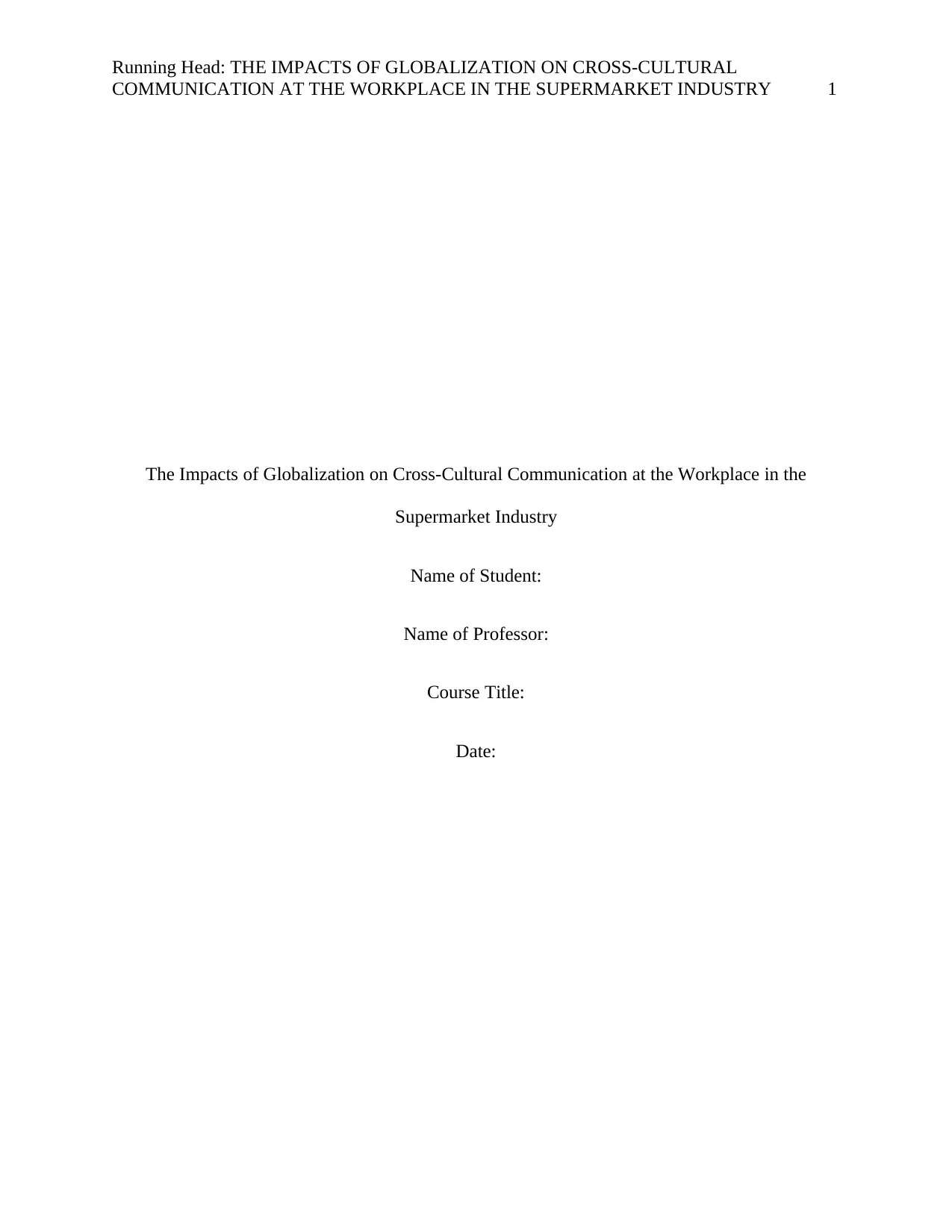
Running Head: THE IMPACTS OF GLOBALIZATION ON CROSS-CULTURAL
COMMUNICATION AT THE WORKPLACE IN THE SUPERMARKET INDUSTRY 1
The Impacts of Globalization on Cross-Cultural Communication at the Workplace in the
Supermarket Industry
Name of Student:
Name of Professor:
Course Title:
Date:
COMMUNICATION AT THE WORKPLACE IN THE SUPERMARKET INDUSTRY 1
The Impacts of Globalization on Cross-Cultural Communication at the Workplace in the
Supermarket Industry
Name of Student:
Name of Professor:
Course Title:
Date:
Paraphrase This Document
Need a fresh take? Get an instant paraphrase of this document with our AI Paraphraser
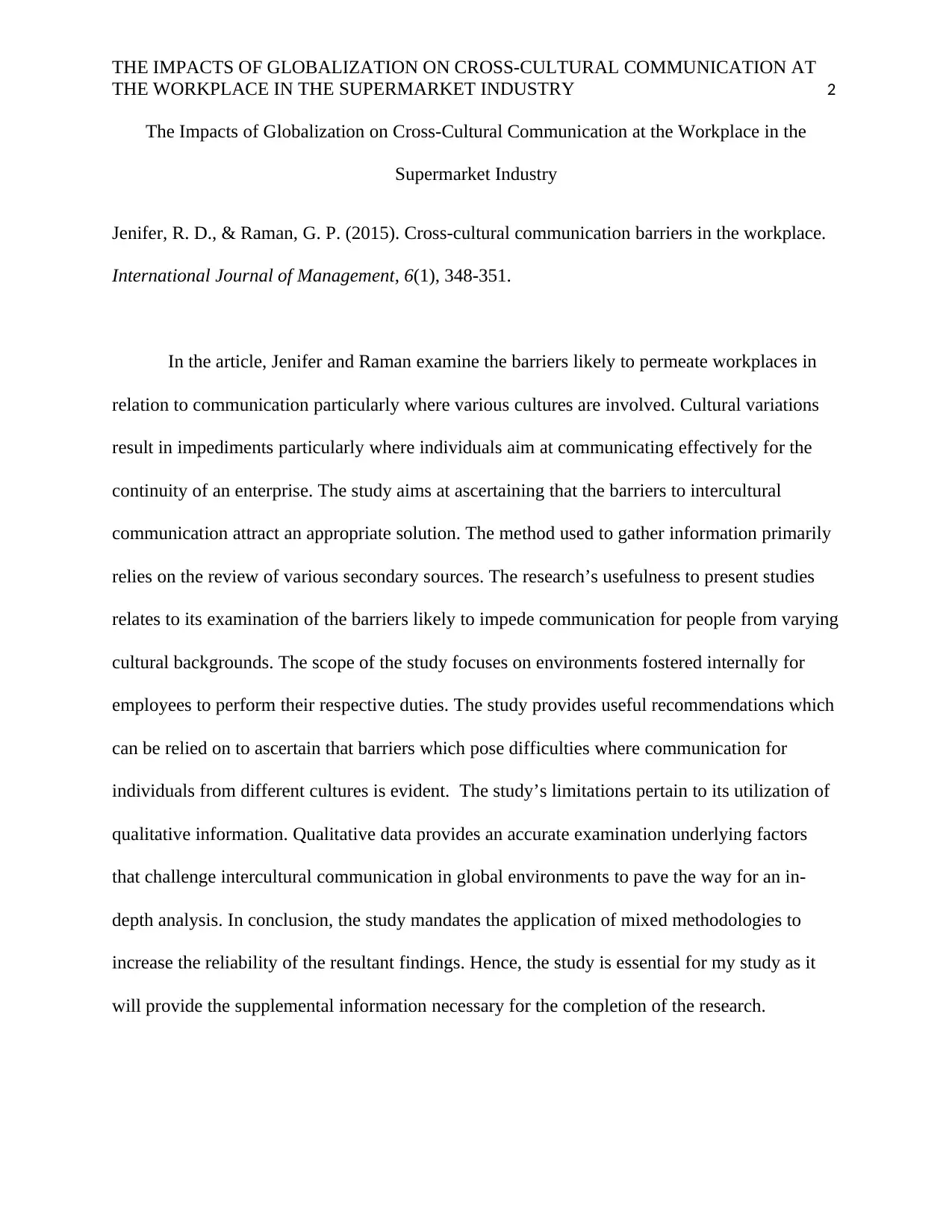
THE IMPACTS OF GLOBALIZATION ON CROSS-CULTURAL COMMUNICATION AT
THE WORKPLACE IN THE SUPERMARKET INDUSTRY 2
The Impacts of Globalization on Cross-Cultural Communication at the Workplace in the
Supermarket Industry
Jenifer, R. D., & Raman, G. P. (2015). Cross-cultural communication barriers in the workplace.
International Journal of Management, 6(1), 348-351.
In the article, Jenifer and Raman examine the barriers likely to permeate workplaces in
relation to communication particularly where various cultures are involved. Cultural variations
result in impediments particularly where individuals aim at communicating effectively for the
continuity of an enterprise. The study aims at ascertaining that the barriers to intercultural
communication attract an appropriate solution. The method used to gather information primarily
relies on the review of various secondary sources. The research’s usefulness to present studies
relates to its examination of the barriers likely to impede communication for people from varying
cultural backgrounds. The scope of the study focuses on environments fostered internally for
employees to perform their respective duties. The study provides useful recommendations which
can be relied on to ascertain that barriers which pose difficulties where communication for
individuals from different cultures is evident. The study’s limitations pertain to its utilization of
qualitative information. Qualitative data provides an accurate examination underlying factors
that challenge intercultural communication in global environments to pave the way for an in-
depth analysis. In conclusion, the study mandates the application of mixed methodologies to
increase the reliability of the resultant findings. Hence, the study is essential for my study as it
will provide the supplemental information necessary for the completion of the research.
THE WORKPLACE IN THE SUPERMARKET INDUSTRY 2
The Impacts of Globalization on Cross-Cultural Communication at the Workplace in the
Supermarket Industry
Jenifer, R. D., & Raman, G. P. (2015). Cross-cultural communication barriers in the workplace.
International Journal of Management, 6(1), 348-351.
In the article, Jenifer and Raman examine the barriers likely to permeate workplaces in
relation to communication particularly where various cultures are involved. Cultural variations
result in impediments particularly where individuals aim at communicating effectively for the
continuity of an enterprise. The study aims at ascertaining that the barriers to intercultural
communication attract an appropriate solution. The method used to gather information primarily
relies on the review of various secondary sources. The research’s usefulness to present studies
relates to its examination of the barriers likely to impede communication for people from varying
cultural backgrounds. The scope of the study focuses on environments fostered internally for
employees to perform their respective duties. The study provides useful recommendations which
can be relied on to ascertain that barriers which pose difficulties where communication for
individuals from different cultures is evident. The study’s limitations pertain to its utilization of
qualitative information. Qualitative data provides an accurate examination underlying factors
that challenge intercultural communication in global environments to pave the way for an in-
depth analysis. In conclusion, the study mandates the application of mixed methodologies to
increase the reliability of the resultant findings. Hence, the study is essential for my study as it
will provide the supplemental information necessary for the completion of the research.
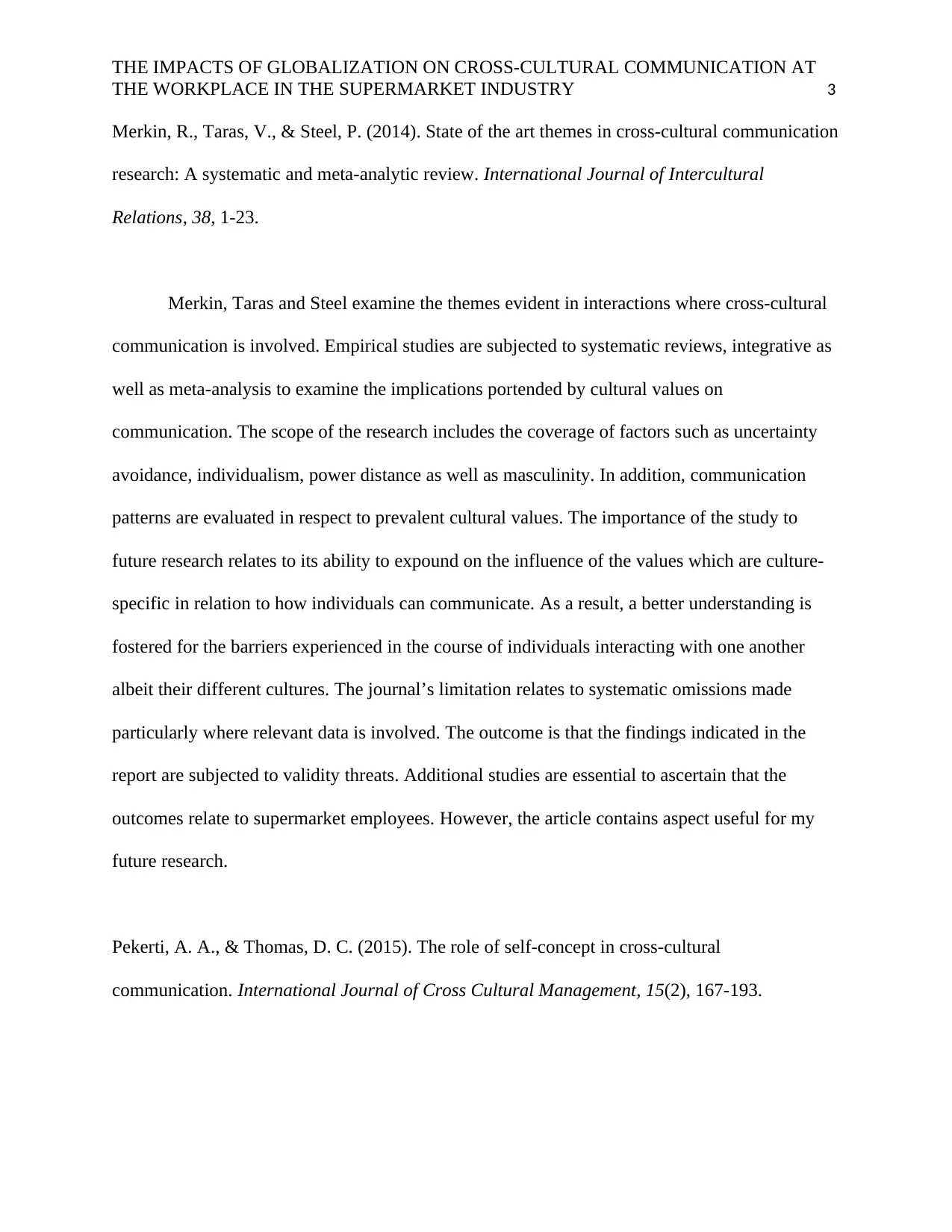
THE IMPACTS OF GLOBALIZATION ON CROSS-CULTURAL COMMUNICATION AT
THE WORKPLACE IN THE SUPERMARKET INDUSTRY 3
Merkin, R., Taras, V., & Steel, P. (2014). State of the art themes in cross-cultural communication
research: A systematic and meta-analytic review. International Journal of Intercultural
Relations, 38, 1-23.
Merkin, Taras and Steel examine the themes evident in interactions where cross-cultural
communication is involved. Empirical studies are subjected to systematic reviews, integrative as
well as meta-analysis to examine the implications portended by cultural values on
communication. The scope of the research includes the coverage of factors such as uncertainty
avoidance, individualism, power distance as well as masculinity. In addition, communication
patterns are evaluated in respect to prevalent cultural values. The importance of the study to
future research relates to its ability to expound on the influence of the values which are culture-
specific in relation to how individuals can communicate. As a result, a better understanding is
fostered for the barriers experienced in the course of individuals interacting with one another
albeit their different cultures. The journal’s limitation relates to systematic omissions made
particularly where relevant data is involved. The outcome is that the findings indicated in the
report are subjected to validity threats. Additional studies are essential to ascertain that the
outcomes relate to supermarket employees. However, the article contains aspect useful for my
future research.
Pekerti, A. A., & Thomas, D. C. (2015). The role of self-concept in cross-cultural
communication. International Journal of Cross Cultural Management, 15(2), 167-193.
THE WORKPLACE IN THE SUPERMARKET INDUSTRY 3
Merkin, R., Taras, V., & Steel, P. (2014). State of the art themes in cross-cultural communication
research: A systematic and meta-analytic review. International Journal of Intercultural
Relations, 38, 1-23.
Merkin, Taras and Steel examine the themes evident in interactions where cross-cultural
communication is involved. Empirical studies are subjected to systematic reviews, integrative as
well as meta-analysis to examine the implications portended by cultural values on
communication. The scope of the research includes the coverage of factors such as uncertainty
avoidance, individualism, power distance as well as masculinity. In addition, communication
patterns are evaluated in respect to prevalent cultural values. The importance of the study to
future research relates to its ability to expound on the influence of the values which are culture-
specific in relation to how individuals can communicate. As a result, a better understanding is
fostered for the barriers experienced in the course of individuals interacting with one another
albeit their different cultures. The journal’s limitation relates to systematic omissions made
particularly where relevant data is involved. The outcome is that the findings indicated in the
report are subjected to validity threats. Additional studies are essential to ascertain that the
outcomes relate to supermarket employees. However, the article contains aspect useful for my
future research.
Pekerti, A. A., & Thomas, D. C. (2015). The role of self-concept in cross-cultural
communication. International Journal of Cross Cultural Management, 15(2), 167-193.
⊘ This is a preview!⊘
Do you want full access?
Subscribe today to unlock all pages.

Trusted by 1+ million students worldwide
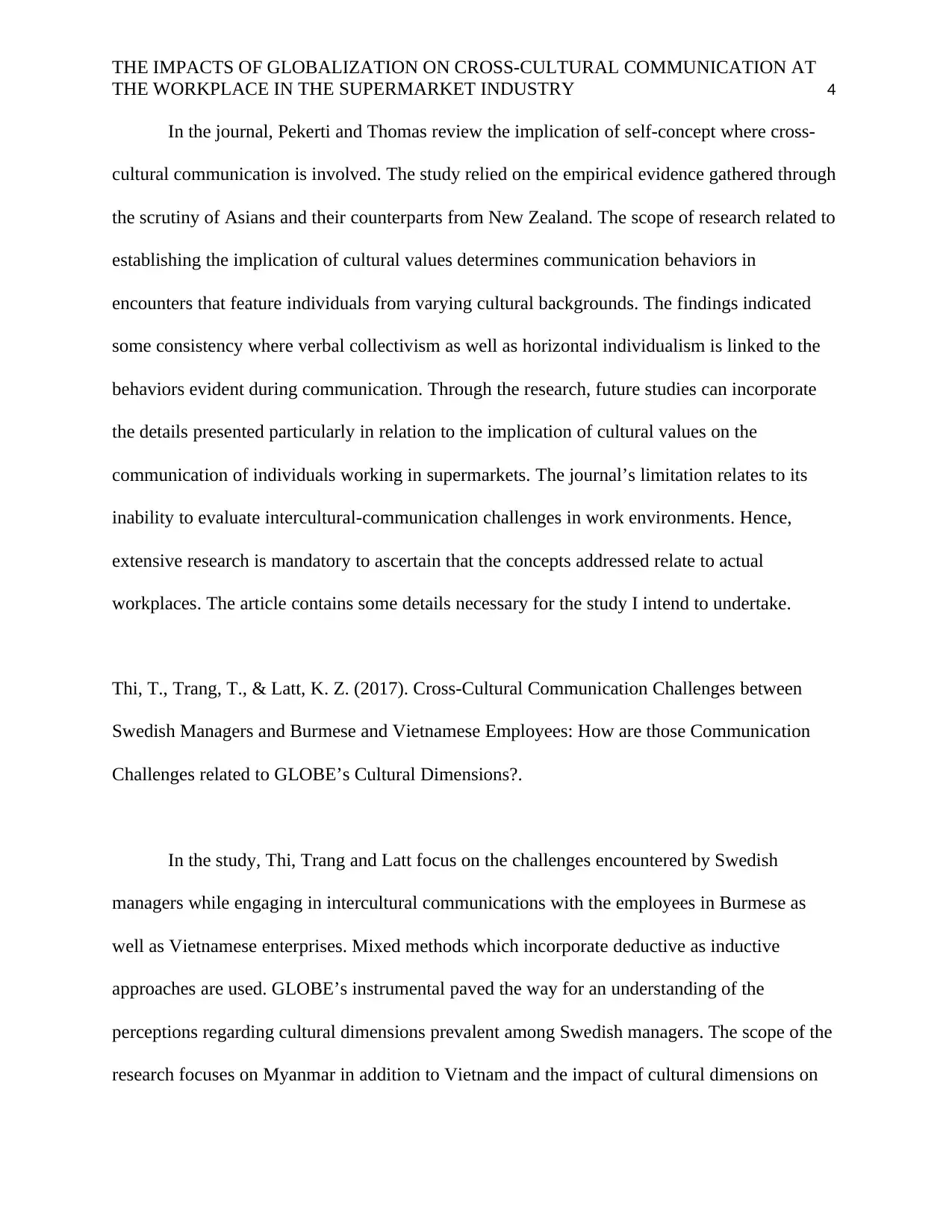
THE IMPACTS OF GLOBALIZATION ON CROSS-CULTURAL COMMUNICATION AT
THE WORKPLACE IN THE SUPERMARKET INDUSTRY 4
In the journal, Pekerti and Thomas review the implication of self-concept where cross-
cultural communication is involved. The study relied on the empirical evidence gathered through
the scrutiny of Asians and their counterparts from New Zealand. The scope of research related to
establishing the implication of cultural values determines communication behaviors in
encounters that feature individuals from varying cultural backgrounds. The findings indicated
some consistency where verbal collectivism as well as horizontal individualism is linked to the
behaviors evident during communication. Through the research, future studies can incorporate
the details presented particularly in relation to the implication of cultural values on the
communication of individuals working in supermarkets. The journal’s limitation relates to its
inability to evaluate intercultural-communication challenges in work environments. Hence,
extensive research is mandatory to ascertain that the concepts addressed relate to actual
workplaces. The article contains some details necessary for the study I intend to undertake.
Thi, T., Trang, T., & Latt, K. Z. (2017). Cross-Cultural Communication Challenges between
Swedish Managers and Burmese and Vietnamese Employees: How are those Communication
Challenges related to GLOBE’s Cultural Dimensions?.
In the study, Thi, Trang and Latt focus on the challenges encountered by Swedish
managers while engaging in intercultural communications with the employees in Burmese as
well as Vietnamese enterprises. Mixed methods which incorporate deductive as inductive
approaches are used. GLOBE’s instrumental paved the way for an understanding of the
perceptions regarding cultural dimensions prevalent among Swedish managers. The scope of the
research focuses on Myanmar in addition to Vietnam and the impact of cultural dimensions on
THE WORKPLACE IN THE SUPERMARKET INDUSTRY 4
In the journal, Pekerti and Thomas review the implication of self-concept where cross-
cultural communication is involved. The study relied on the empirical evidence gathered through
the scrutiny of Asians and their counterparts from New Zealand. The scope of research related to
establishing the implication of cultural values determines communication behaviors in
encounters that feature individuals from varying cultural backgrounds. The findings indicated
some consistency where verbal collectivism as well as horizontal individualism is linked to the
behaviors evident during communication. Through the research, future studies can incorporate
the details presented particularly in relation to the implication of cultural values on the
communication of individuals working in supermarkets. The journal’s limitation relates to its
inability to evaluate intercultural-communication challenges in work environments. Hence,
extensive research is mandatory to ascertain that the concepts addressed relate to actual
workplaces. The article contains some details necessary for the study I intend to undertake.
Thi, T., Trang, T., & Latt, K. Z. (2017). Cross-Cultural Communication Challenges between
Swedish Managers and Burmese and Vietnamese Employees: How are those Communication
Challenges related to GLOBE’s Cultural Dimensions?.
In the study, Thi, Trang and Latt focus on the challenges encountered by Swedish
managers while engaging in intercultural communications with the employees in Burmese as
well as Vietnamese enterprises. Mixed methods which incorporate deductive as inductive
approaches are used. GLOBE’s instrumental paved the way for an understanding of the
perceptions regarding cultural dimensions prevalent among Swedish managers. The scope of the
research focuses on Myanmar in addition to Vietnam and the impact of cultural dimensions on
Paraphrase This Document
Need a fresh take? Get an instant paraphrase of this document with our AI Paraphraser
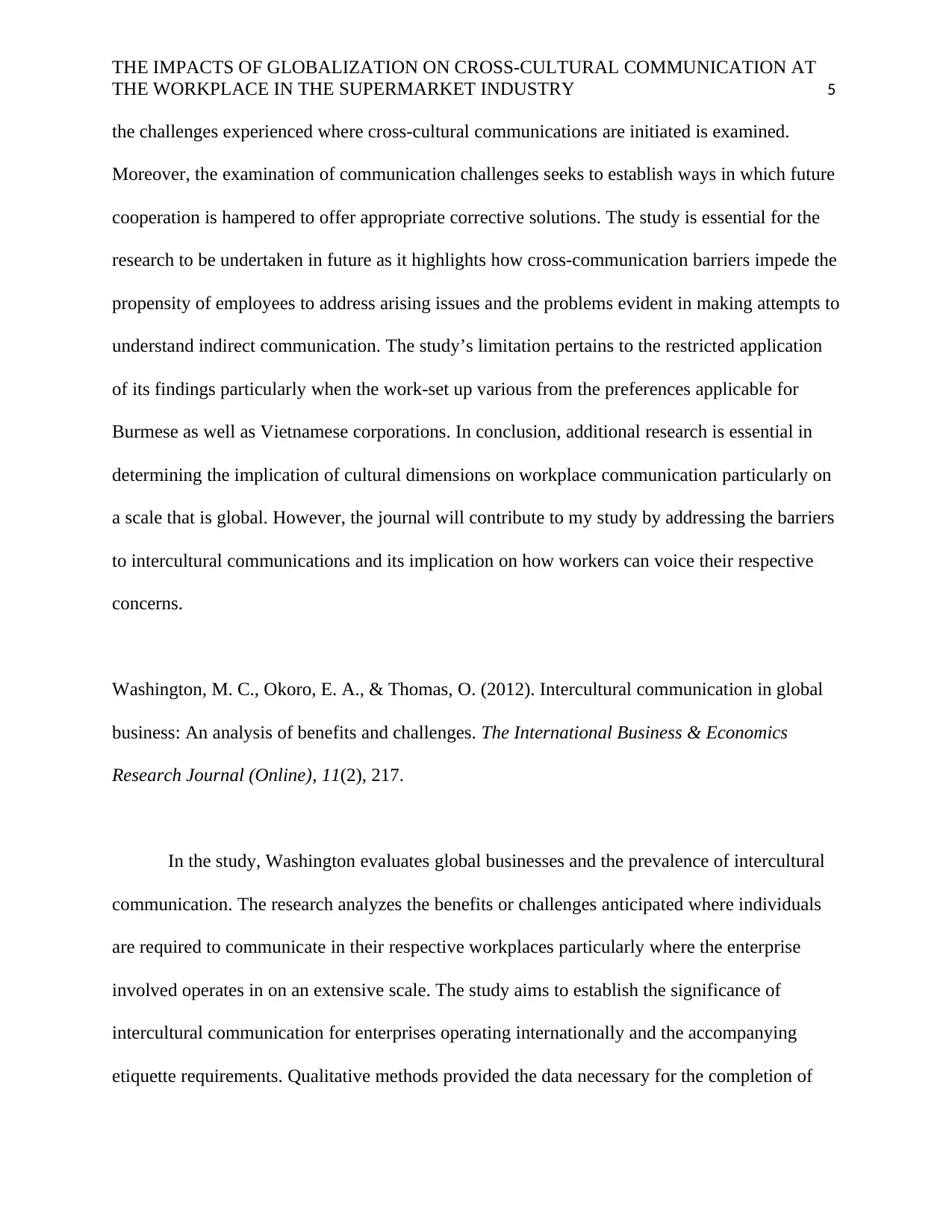
THE IMPACTS OF GLOBALIZATION ON CROSS-CULTURAL COMMUNICATION AT
THE WORKPLACE IN THE SUPERMARKET INDUSTRY 5
the challenges experienced where cross-cultural communications are initiated is examined.
Moreover, the examination of communication challenges seeks to establish ways in which future
cooperation is hampered to offer appropriate corrective solutions. The study is essential for the
research to be undertaken in future as it highlights how cross-communication barriers impede the
propensity of employees to address arising issues and the problems evident in making attempts to
understand indirect communication. The study’s limitation pertains to the restricted application
of its findings particularly when the work-set up various from the preferences applicable for
Burmese as well as Vietnamese corporations. In conclusion, additional research is essential in
determining the implication of cultural dimensions on workplace communication particularly on
a scale that is global. However, the journal will contribute to my study by addressing the barriers
to intercultural communications and its implication on how workers can voice their respective
concerns.
Washington, M. C., Okoro, E. A., & Thomas, O. (2012). Intercultural communication in global
business: An analysis of benefits and challenges. The International Business & Economics
Research Journal (Online), 11(2), 217.
In the study, Washington evaluates global businesses and the prevalence of intercultural
communication. The research analyzes the benefits or challenges anticipated where individuals
are required to communicate in their respective workplaces particularly where the enterprise
involved operates in on an extensive scale. The study aims to establish the significance of
intercultural communication for enterprises operating internationally and the accompanying
etiquette requirements. Qualitative methods provided the data necessary for the completion of
THE WORKPLACE IN THE SUPERMARKET INDUSTRY 5
the challenges experienced where cross-cultural communications are initiated is examined.
Moreover, the examination of communication challenges seeks to establish ways in which future
cooperation is hampered to offer appropriate corrective solutions. The study is essential for the
research to be undertaken in future as it highlights how cross-communication barriers impede the
propensity of employees to address arising issues and the problems evident in making attempts to
understand indirect communication. The study’s limitation pertains to the restricted application
of its findings particularly when the work-set up various from the preferences applicable for
Burmese as well as Vietnamese corporations. In conclusion, additional research is essential in
determining the implication of cultural dimensions on workplace communication particularly on
a scale that is global. However, the journal will contribute to my study by addressing the barriers
to intercultural communications and its implication on how workers can voice their respective
concerns.
Washington, M. C., Okoro, E. A., & Thomas, O. (2012). Intercultural communication in global
business: An analysis of benefits and challenges. The International Business & Economics
Research Journal (Online), 11(2), 217.
In the study, Washington evaluates global businesses and the prevalence of intercultural
communication. The research analyzes the benefits or challenges anticipated where individuals
are required to communicate in their respective workplaces particularly where the enterprise
involved operates in on an extensive scale. The study aims to establish the significance of
intercultural communication for enterprises operating internationally and the accompanying
etiquette requirements. Qualitative methods provided the data necessary for the completion of
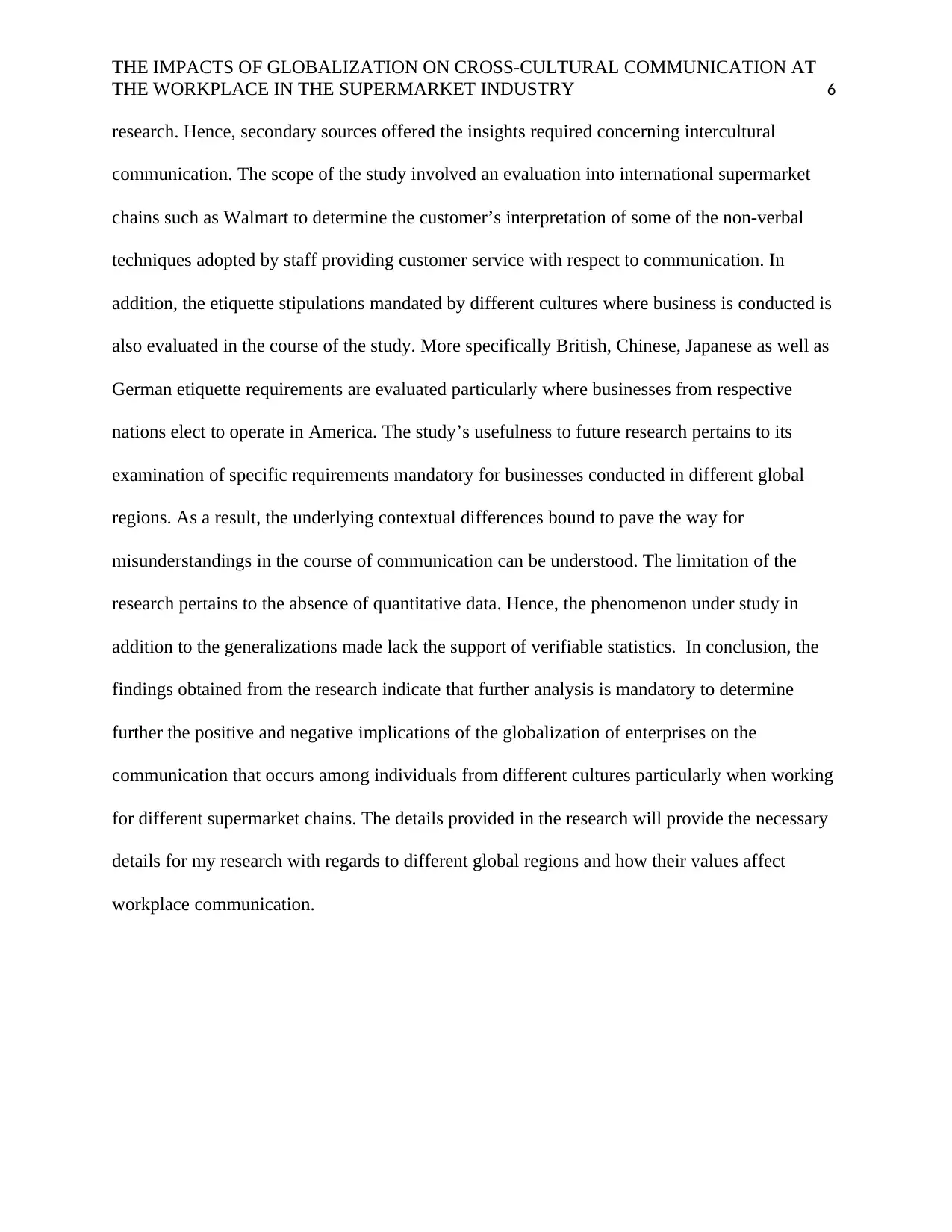
THE IMPACTS OF GLOBALIZATION ON CROSS-CULTURAL COMMUNICATION AT
THE WORKPLACE IN THE SUPERMARKET INDUSTRY 6
research. Hence, secondary sources offered the insights required concerning intercultural
communication. The scope of the study involved an evaluation into international supermarket
chains such as Walmart to determine the customer’s interpretation of some of the non-verbal
techniques adopted by staff providing customer service with respect to communication. In
addition, the etiquette stipulations mandated by different cultures where business is conducted is
also evaluated in the course of the study. More specifically British, Chinese, Japanese as well as
German etiquette requirements are evaluated particularly where businesses from respective
nations elect to operate in America. The study’s usefulness to future research pertains to its
examination of specific requirements mandatory for businesses conducted in different global
regions. As a result, the underlying contextual differences bound to pave the way for
misunderstandings in the course of communication can be understood. The limitation of the
research pertains to the absence of quantitative data. Hence, the phenomenon under study in
addition to the generalizations made lack the support of verifiable statistics. In conclusion, the
findings obtained from the research indicate that further analysis is mandatory to determine
further the positive and negative implications of the globalization of enterprises on the
communication that occurs among individuals from different cultures particularly when working
for different supermarket chains. The details provided in the research will provide the necessary
details for my research with regards to different global regions and how their values affect
workplace communication.
THE WORKPLACE IN THE SUPERMARKET INDUSTRY 6
research. Hence, secondary sources offered the insights required concerning intercultural
communication. The scope of the study involved an evaluation into international supermarket
chains such as Walmart to determine the customer’s interpretation of some of the non-verbal
techniques adopted by staff providing customer service with respect to communication. In
addition, the etiquette stipulations mandated by different cultures where business is conducted is
also evaluated in the course of the study. More specifically British, Chinese, Japanese as well as
German etiquette requirements are evaluated particularly where businesses from respective
nations elect to operate in America. The study’s usefulness to future research pertains to its
examination of specific requirements mandatory for businesses conducted in different global
regions. As a result, the underlying contextual differences bound to pave the way for
misunderstandings in the course of communication can be understood. The limitation of the
research pertains to the absence of quantitative data. Hence, the phenomenon under study in
addition to the generalizations made lack the support of verifiable statistics. In conclusion, the
findings obtained from the research indicate that further analysis is mandatory to determine
further the positive and negative implications of the globalization of enterprises on the
communication that occurs among individuals from different cultures particularly when working
for different supermarket chains. The details provided in the research will provide the necessary
details for my research with regards to different global regions and how their values affect
workplace communication.
⊘ This is a preview!⊘
Do you want full access?
Subscribe today to unlock all pages.

Trusted by 1+ million students worldwide
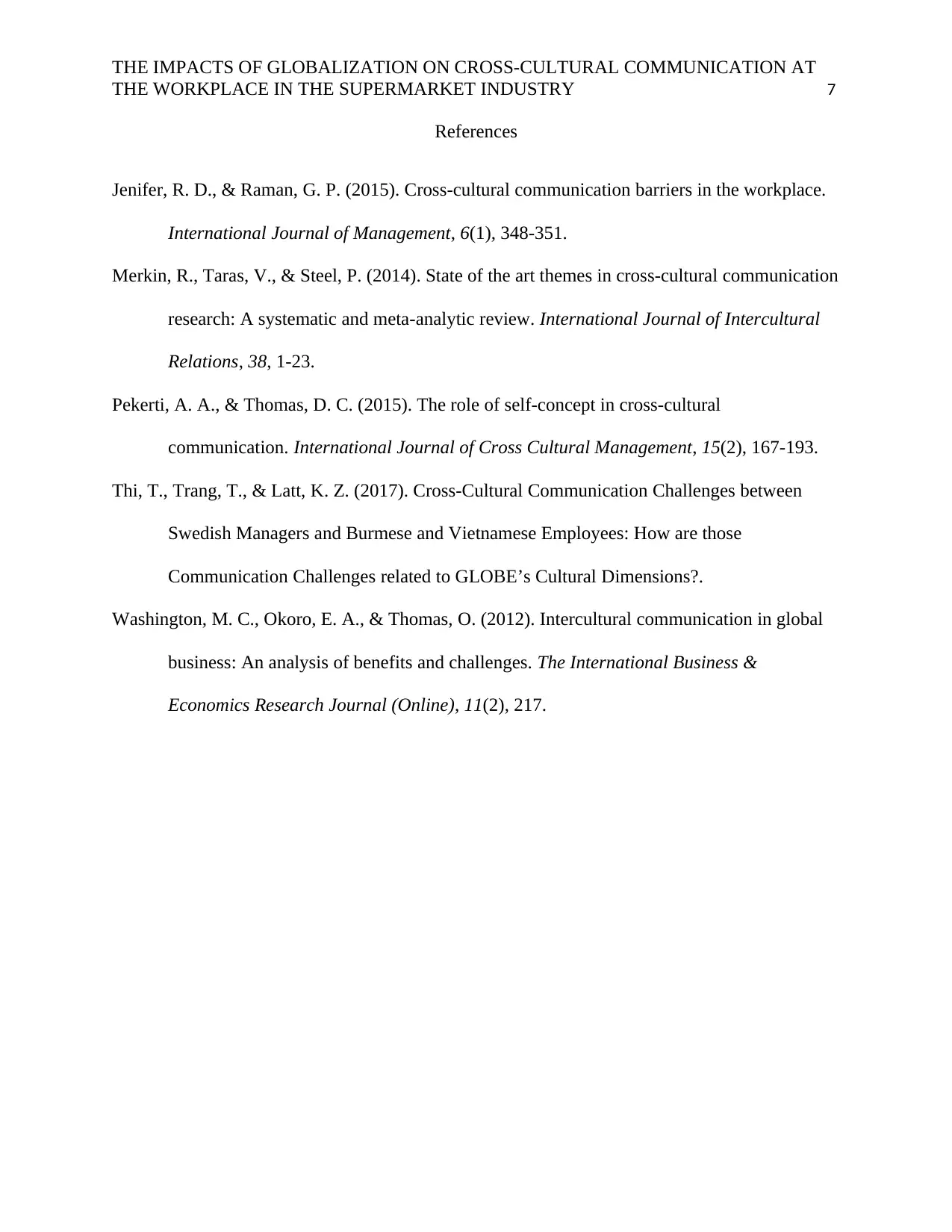
THE IMPACTS OF GLOBALIZATION ON CROSS-CULTURAL COMMUNICATION AT
THE WORKPLACE IN THE SUPERMARKET INDUSTRY 7
References
Jenifer, R. D., & Raman, G. P. (2015). Cross-cultural communication barriers in the workplace.
International Journal of Management, 6(1), 348-351.
Merkin, R., Taras, V., & Steel, P. (2014). State of the art themes in cross-cultural communication
research: A systematic and meta-analytic review. International Journal of Intercultural
Relations, 38, 1-23.
Pekerti, A. A., & Thomas, D. C. (2015). The role of self-concept in cross-cultural
communication. International Journal of Cross Cultural Management, 15(2), 167-193.
Thi, T., Trang, T., & Latt, K. Z. (2017). Cross-Cultural Communication Challenges between
Swedish Managers and Burmese and Vietnamese Employees: How are those
Communication Challenges related to GLOBE’s Cultural Dimensions?.
Washington, M. C., Okoro, E. A., & Thomas, O. (2012). Intercultural communication in global
business: An analysis of benefits and challenges. The International Business &
Economics Research Journal (Online), 11(2), 217.
THE WORKPLACE IN THE SUPERMARKET INDUSTRY 7
References
Jenifer, R. D., & Raman, G. P. (2015). Cross-cultural communication barriers in the workplace.
International Journal of Management, 6(1), 348-351.
Merkin, R., Taras, V., & Steel, P. (2014). State of the art themes in cross-cultural communication
research: A systematic and meta-analytic review. International Journal of Intercultural
Relations, 38, 1-23.
Pekerti, A. A., & Thomas, D. C. (2015). The role of self-concept in cross-cultural
communication. International Journal of Cross Cultural Management, 15(2), 167-193.
Thi, T., Trang, T., & Latt, K. Z. (2017). Cross-Cultural Communication Challenges between
Swedish Managers and Burmese and Vietnamese Employees: How are those
Communication Challenges related to GLOBE’s Cultural Dimensions?.
Washington, M. C., Okoro, E. A., & Thomas, O. (2012). Intercultural communication in global
business: An analysis of benefits and challenges. The International Business &
Economics Research Journal (Online), 11(2), 217.
1 out of 7
Related Documents
Your All-in-One AI-Powered Toolkit for Academic Success.
+13062052269
info@desklib.com
Available 24*7 on WhatsApp / Email
![[object Object]](/_next/static/media/star-bottom.7253800d.svg)
Unlock your academic potential
Copyright © 2020–2025 A2Z Services. All Rights Reserved. Developed and managed by ZUCOL.




